Back in the day the VRod was the Harley that everyone wanted and for many that still holds true today; if you’re after a retro-custom look and something horrifyingly loud this be it.
But if it’s a more modern custom design you’re after, then it’s hard to overlook the Breakout. This is the Softail model with the most raked out forks (34 degrees) and with a huge 240/40R18 Michelin Scorcher rear tyre.
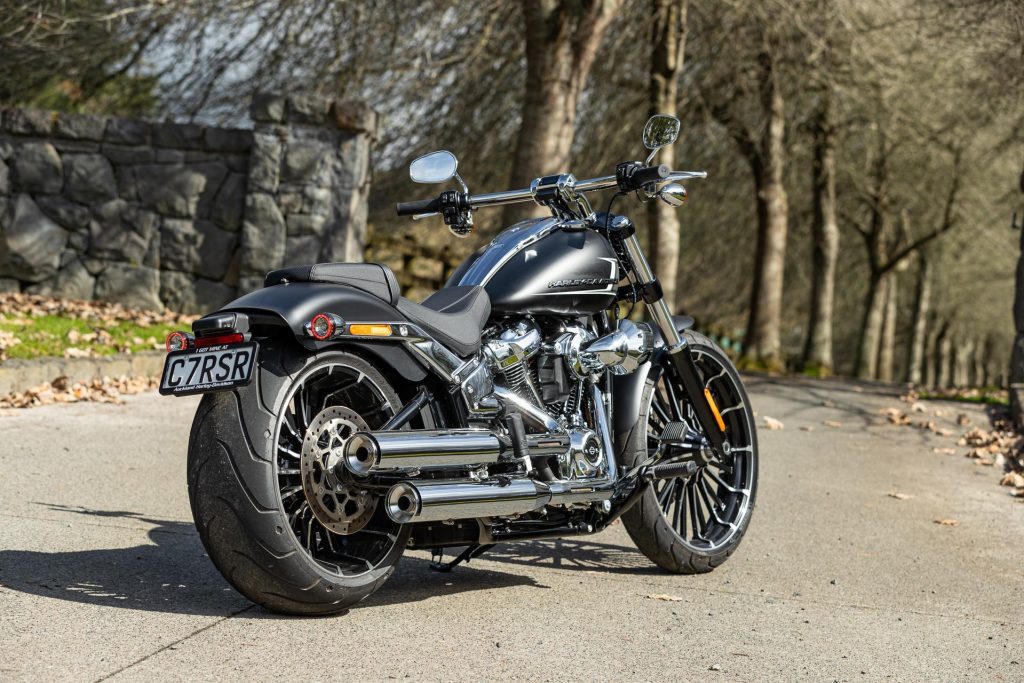
It (the bike, not the rear wheel) comes in a beautiful orange hue too, for not much extra, though matte black also works well, as you can see.
And there’s enough chrome to make sunnies absolutely mandatory on a clear day.
There’s brightwork for the pipes, the right-sided “heavy breather” air intake that’s close to your right knee, the bars, the indicators, the mirrors, the side covers, and even the rear fender brackets are chromed. Shiny. Visually, the Breakout is bbbad to the bbbone.
New for the latest version is a larger tank, customers complaining of range with the 2018 model.
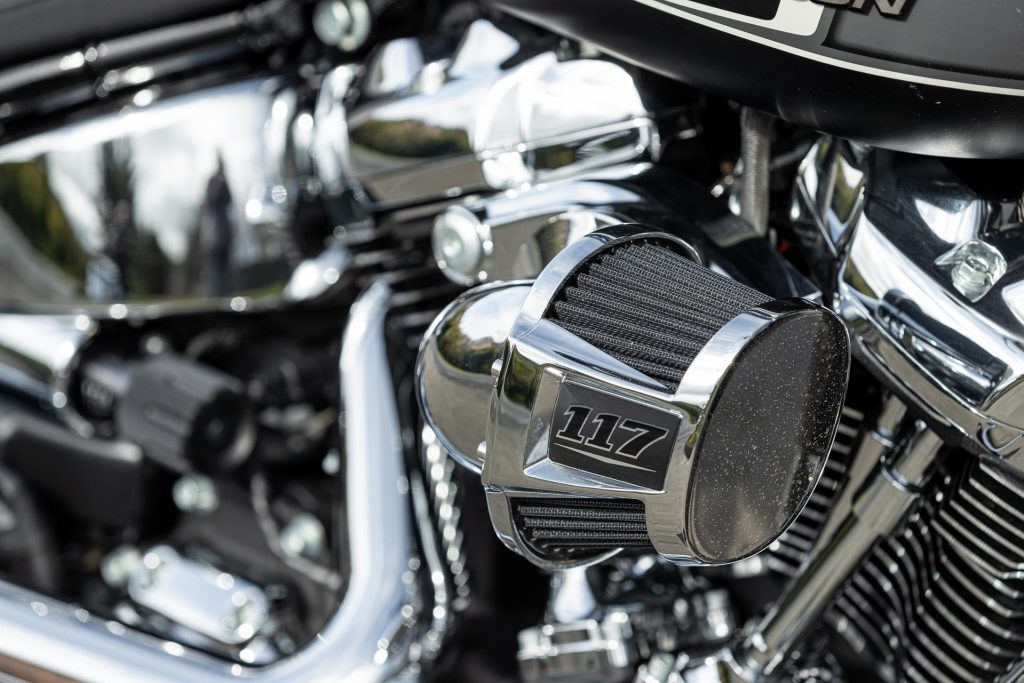
It’s now 5L bigger at 18.9L for an approximate touring range of 350km, and the wheel designs are new too, 26-spoke though still with a 21-inch front (130/60B21).
Riding comfort improves with a new horizontal shock that’s preload adjustable on the go, with the remote wheel just beneath your right leg.
The engine though is the main difference, Breakout picking up the 117 cubic inch mill instead of the 114, so 1923cc, and offering up almost 170Nm of torque at 3500rpm.
There’s 76kW of power on tap, developed at just over 5000rpm. Not that the old one was wanting in the output department. It’s just that a bit more grunt never hurts, right?
As to equipment this is somewhat limited, with no engine modes but there’s the mandated ABS while TC is optional and switchable.
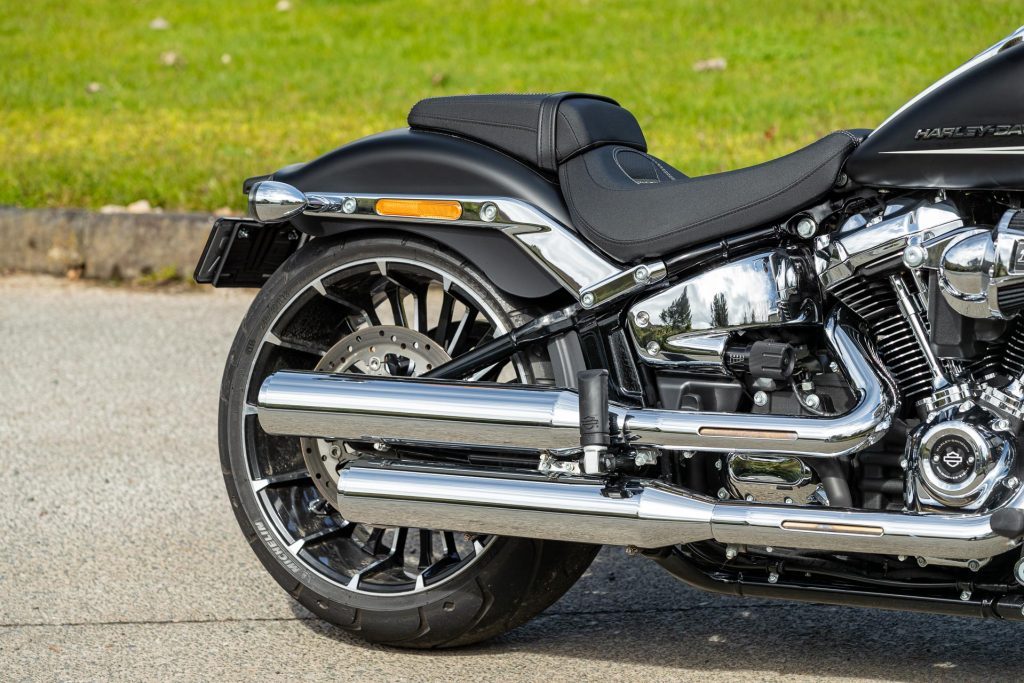
There’s keyless start and cruise control, the latter simple to work, with just a push in to standby mode and a push down to set speed.
There are some traditional features too, like the self-cancelling indicators on the right and left switch blocks, and the unadjustable hand levers for the clutch and front brake.
As per, these are built for the Jack Reachers rather than the Tom Cruises of this world. Being in the latter group, (for hand, not wallet size) we’d put in a request for lever adjustability.
This has a fairly comfortable riding position, the bars slightly closer than they were on the 2021 bike as the risers are almost 20mm higher (they’re angled back towards you).
The LCD screen is so laughably small you might wonder where it is without the ignition on. Turns out it sits atop the handlebar holders.
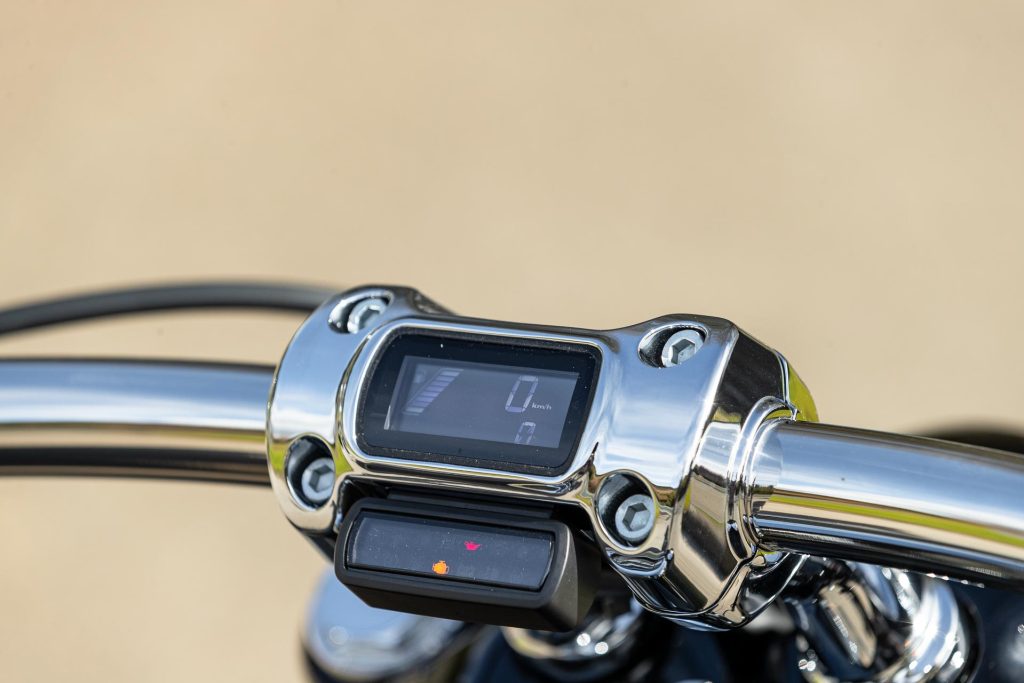
While it seems to impart precious little in the way of information, we rather like that. Set the bottom readout to revs, trip, range to empty or whatever, only not fuel use; there’s a separate gauge for that and it doesn’t tell you the average consumption figure.
Harley suggests 5.6L/100km. We quite like the minimalism of it though; essentially you only look down to check on the speed and what gear you’re in so there’s very little in the way of distraction.
Speaking of, you might find the hero blobs on the feet-forward pegs touching down on occasion, through tighter bends.
You only need to lean it over to 27 degrees before the sparks fly. But ridden in more cruisy fashion as the design would suggest and progress is good.
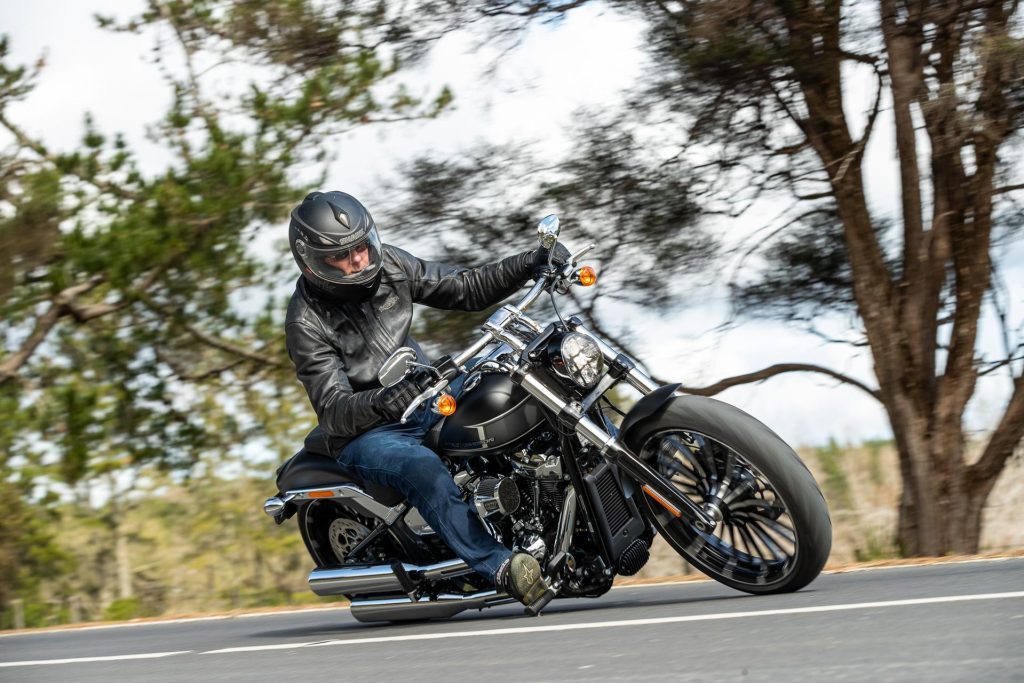
Better than on the last iteration too which wasn’t so easygoing over rough roads; this soaks up the bumps better, though for real unruly roads it’s best to weight up the pegs and unweight your bum slightly.
Evidently the seat was reshaped to accommodate the bigger tank, and the riding position isn’t quite so raked out either.
Whatever, we managed a few longish stints with no sore bits resulting. If you’re feeling like a change of position, you can rest your feet on the rear pegs for a bit which makes it feel more like a sports bike.
We rode the Fat Boy not so long ago, and that too had a huge 240 section rear tyre but where that was a bit precious about taking tight turns and didn’t want to change direction that easily at slower speeds, this isn’t like that.
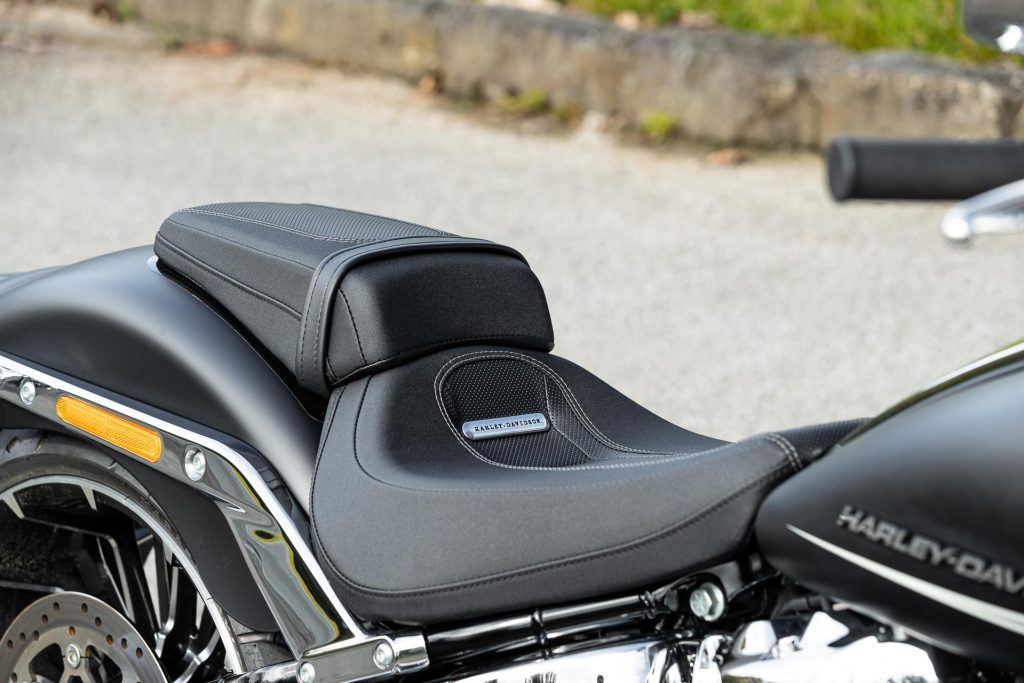
We’d suggest the bigger front wheel with the skinnier tyre makes the difference, as the extra fork rake and 30mm longer wheelbase probably wouldn’t help in that regard.
Whatever, it isn’t so averse to tighter turns, and even U-turns aren’t as precarious as you might expect. You can do them feet up once you’re in the groove.
The previous version was pretty quick, not quite dragster fast but any figure under 4sec (3.83) for the 0-100 sprint isn’t hanging around for a cruiser, and nor is an overtake of 2.53sec.
But the bigger dog is faster (3.70sec), more especially on the overtake, requiring just 2.17sec to gap it from 80 to 120km/h.
Its shift mechanism is typically Harley, best done sooner than later and with some early upward pressure and a brief delay to avoid clunking as you select a higher gear.
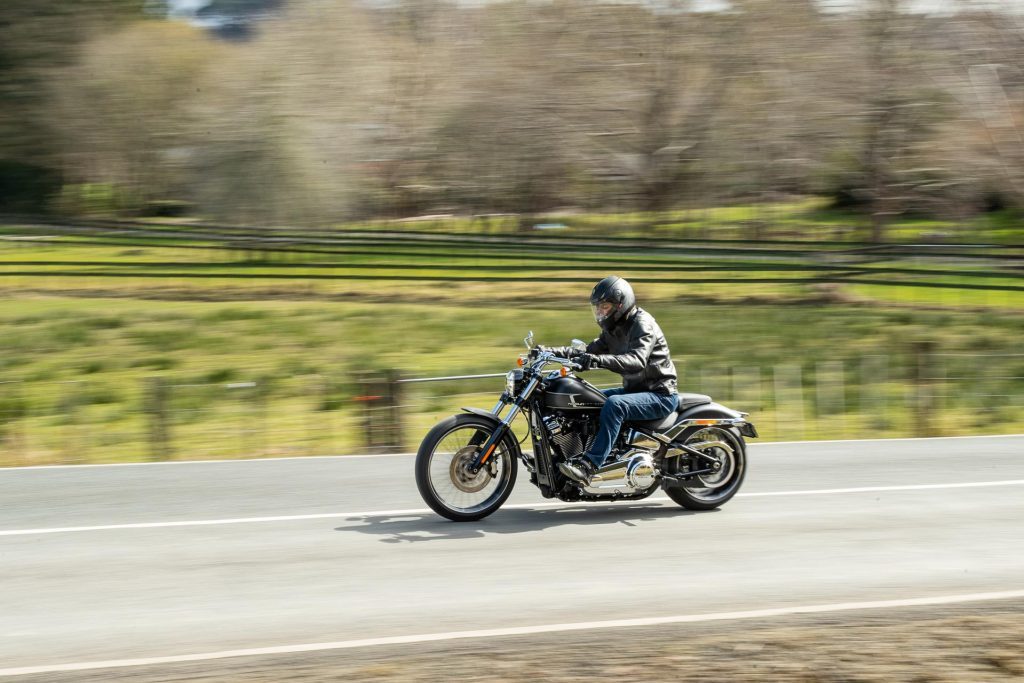
Downshifts require an assertive blip but this is a solid, positive shifter when it’s done right.
So it’s powerful quick, faster than all but a handful of cars, though that’s rather beside the point as you ride it mainly down around 1800-2500rpm, not above 5000 where it soon runs out of puff.
The open road speed is a loafing 2250rpm in sixth, and 110 is still below 2500rpm. Vibes are of the friendly variety, reminding you there’s almost a 2L mill between your legs.
Oddly, the mirrors are no use at 80km/h but are clear as day around 100km/h.
The best stopping distance was similar to that of its predecessor, a touch over 36m.
Despite only having a single front disc the caliper has four pots, and the rearward weight bias makes the back brake a significant contributor to stopping distances.
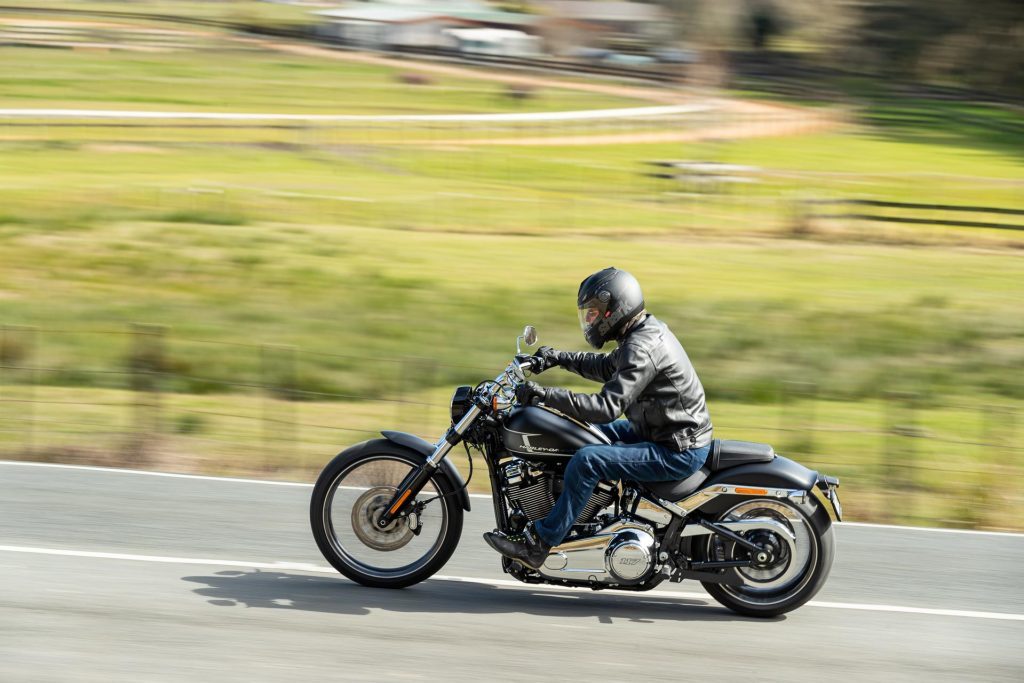
It is more expensive than when we last rode it in 2021, now at $40,750 for this black version but then there’s the new upsized engine and the Kiwi dollar is tanking against the Greenback so an extra $4k you wouldn’t quibble about.
Except that some of its rivals cost less or are no more expensive and are quicker and handle better; we’re thinking Diavel and Triumph Rocket III here, though neither has quite the custom bike look of the Breakout.
But something like the Indian Chief Dark Horse or Sport does, and they cost less too. You’re spoilt for choice in this sector.
| Model | Harley-Davidson Breakout 117 |
| Price | $40,750 |
| Format | Air/Oil cooled / Fuel Injected / V2 |
| Engine | 1923cc |
| Max Power | 76 kW @ 5020 rpm |
| Max Torque | 167 Nm @ 3500 rpm |
| Cylinder Head | SOHC / 8v |
| Gearbox | 6-speed |
| Drivetrain | Belt final drive |
| Front Suspension | 49mm forks, no adjustment |
| Rear Suspension | Monoshock, preload adjustable |
| Front Brakes | Four-piston calipers, 300mm disc |
| Rear Brakes | Twin-piston calipers, 292mm disc |
| Safety Systems | ABS |
| Tyre Size | F – 130/60ZR21 / R – 240/40ZR18 |
| Tyres | Michelin Scorcher |
| Wheelbase | 1695mm |
| Seat Height | 665mm |
| Rake/Trail | 34 degrees / 145mm |
| Fuel Capacity | 18.9 L |
| Measured Weight | 310 kg |
| Weight Distribution | F – 140 kg / R – 170 kg |
This article first appeared in the December/January issue of NZ Autocar Magazine.


